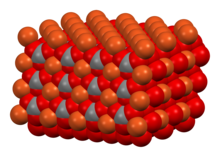
| |
| Names | |
|---|---|
| IUPAC name Copper(II) carbonate | |
| Other names Cupric carbonate, neutral copper carbonate | |
| Identifiers | |
| CAS Number | |
| 3D model (JSmol) | |
| ChemSpider | |
| ECHA InfoCard | 100.013.338 |
| EC Number |
|
| PubChem CID | |
| UNII | |
| CompTox Dashboard (EPA) | |
InChI
| |
SMILES
| |
| Properties | |
| Chemical formula | CuCO3 |
| Molar mass | 123.5549 |
| Appearance | green or blue Powder |
| Solubility in water | insoluble in water |
| Solubility product (Ksp) | 10 at 25 °C. |
| Structure | |
| Space group | Pa-Cs (7) |
| Lattice constant | a = 6.092 Å, b = 4.493 Å, c = 7.030 Åα = 90°, β = 101,34°°, γ = 90° |
| Coordination geometry | 5 |
| Hazards | |
| Flash point | Non-flammable |
| Related compounds | |
| Other anions | Copper(II) sulfate |
| Other cations | Nickel(II) carbonate Zinc carbonate |
| Except where otherwise noted, data are given for materials in their standard state (at 25 °C , 100 kPa).
| |
Copper(II) carbonate or cupric carbonate is a chemical compound with formula CuCO
3. At ambient temperatures, it is an ionic solid (a salt) consisting of copper(II) cations Cu
and carbonate anions CO
3.
This compound is rarely encountered because it is difficult to prepare and readily reacts with water moisture from the air. The terms "copper carbonate", "copper(II) carbonate", and "cupric carbonate" almost always refer (even in chemistry texts) to a basic copper carbonate (or copper(II) carbonate hydroxide), such as Cu
2(OH)2CO
3 (which occurs naturally as the mineral malachite) or Cu
3(OH)2(CO
3)2 (azurite). For this reason, the qualifier neutral may be used instead of "basic" to refer specifically to CuCO
3.
Preparation
Reactions that may be expected to yield CuCO
3, such as mixing solutions of copper(II) sulfate CuSO
4 and sodium carbonate in ambient conditions, yield instead a basic carbonate and CO
2, due to the great affinity of the Cu
ion for the hydroxide anion HO
.
Thermal decomposition of the basic carbonate at atmospheric pressure yields copper(II) oxide rather than the carbonate.
In 1960, C. W. F. T. Pistorius claimed synthesis by heating basic copper carbonate at 180 °C in an atmosphere of carbon dioxide (450 atm) and water (50 atm) for 36 hours. The bulk of the products was well-crystallized malachite Cu
2CO
3(OH)2, but a small yield of a rhombohedral substance was also obtained, claimed to be CuCO
3. However, this synthesis was apparently not reproduced.
Reliable synthesis of true copper(II) carbonate was reported for the first time in 1973 by Hartmut Ehrhardt et al. The compound was obtained as a gray powder, by heating basic copper carbonate in an atmosphere of carbon dioxide (produced by the decomposition of silver oxalate Ag
2C
2O
4) at 500 °C and 2 GPa (20,000 atm). The compound was determined to have a monoclinic structure.
Chemical and physical properties
The stability of dry CuCO
3 depends critically on the partial pressure of carbon dioxide (pCO2). It is stable for months in dry air, but decomposes slowly into CuO and CO
2 if pCO2 is less than 0.11 atm.
In the presence of water or moist air at 25 °C, CuCO
3 is stable only for pCO2 above 4.57 atmospheres and pH between about 4 and 8. Below that partial pressure, it reacts with water to form a basic carbonate (azurite, Cu
3(CO
3)2(OH)2).
- 3 CuCO
3 + H
2O → Cu
3(CO
3)
2(OH)
2 + CO
2
In highly basic solutions, the complex anion Cu(CO
3)
2 is formed instead.
The solubility product of the true copper(II) carbonate was measured by Reiterer and others as pKso = 11.45 ± 0.10 at 25 °C.
Structure
In the crystal structure of CuCO3, copper adopts a distorted square pyramidal coordination environment with coordination number 5. Each carbonate ion bonds to 5 copper centres.
-
 Unit cell of CuCO3
Unit cell of CuCO3
-
 Copper coordination environment
Copper coordination environment
-
 Carbonate coordination environment
Carbonate coordination environment
References
- ^ H. Seidel, H. Ehrhardt, K. Viswanathan, W. Johannes (1974): "Darstellung, Struktur und Eigenschaften von Kupfer(II)-Carbonat". Z. anorg. allg. Chem., volume 410, pages 138-148. doi:10.1002/zaac.19744100207
- ^ Rolf Grauer (1999) "Solubility Products of M(II) Carbonates Archived 2018-11-01 at the Wayback Machine". Technical Report NTB-99-03, NAGRA - National Cooperative for the Disposal of Radioactive Waste; pages 8, 14, and 17. Translated by U. Berner.
- ^ F. Reiterer, W. Johannes, H. Gamsjäger (1981): "Semimicro Determination of Solubility Constants: Copper(II) Carbonate and Iron(II) Carbonate". Mikrochim. Acta, volume 1981, page 63. doi:10.1007/BF01198705
- ^ F. Reiterer (1980): "Löslichkeitskonstanten und Freie Bildungsenthalpien neutraler Übergangsmetallcarbonate". Thesis, Montanuniversität Leoben.
- Ahmad, Zaki (2006). Principles of Corrosion Engineering and Corrosion Control. Oxford: Butterworth-Heinemann. pp. 120–270. ISBN 9780750659246.
- C. W. F. T. Pistorius (1960): "Synthesis at High Pressure and Lattice Constants of Normal Cupric Carbonate". Experientia, volume XVI, page 447-448. doi:10.1007/BF02171142
- Hartmut Erhardt, Wilhelm Johannes, and Hinrich Seidel (1973): "Hochdrucksynthese von Kupfer(II)-Carbonat", Z. Naturforsch., volume 28b, issue 9-10, page 682. doi:10.1515/znb-1973-9-1021
- H. Gamsjäger and W. Preis (1999): "Copper Content in Synthetic Copper Carbonate." Letter to J. Chem. Educ., volume 76, issue 10, page 1339. doi:10.1021/ed076p1339.1
| Compounds containing the carbonate group | ||||||||||||||||||||||||||||||||||||||||||||||||||||||||||||||||||||||||||||||||||||||||||||||||||||||||||||||||||||||||||||||||||||||||||||||||||||||||||||||||||||
|---|---|---|---|---|---|---|---|---|---|---|---|---|---|---|---|---|---|---|---|---|---|---|---|---|---|---|---|---|---|---|---|---|---|---|---|---|---|---|---|---|---|---|---|---|---|---|---|---|---|---|---|---|---|---|---|---|---|---|---|---|---|---|---|---|---|---|---|---|---|---|---|---|---|---|---|---|---|---|---|---|---|---|---|---|---|---|---|---|---|---|---|---|---|---|---|---|---|---|---|---|---|---|---|---|---|---|---|---|---|---|---|---|---|---|---|---|---|---|---|---|---|---|---|---|---|---|---|---|---|---|---|---|---|---|---|---|---|---|---|---|---|---|---|---|---|---|---|---|---|---|---|---|---|---|---|---|---|---|---|---|---|---|---|---|
| ||||||||||||||||||||||||||||||||||||||||||||||||||||||||||||||||||||||||||||||||||||||||||||||||||||||||||||||||||||||||||||||||||||||||||||||||||||||||||||||||||||
| Hydroxides | ||||||||||||||||||||||||||||||||||||||||||||||||||||||||||||||||||||||||||||||||||||||||||||||||||||||||||||||||||||||||||||||||||||||||||||||||||||||||||||||||||||
|---|---|---|---|---|---|---|---|---|---|---|---|---|---|---|---|---|---|---|---|---|---|---|---|---|---|---|---|---|---|---|---|---|---|---|---|---|---|---|---|---|---|---|---|---|---|---|---|---|---|---|---|---|---|---|---|---|---|---|---|---|---|---|---|---|---|---|---|---|---|---|---|---|---|---|---|---|---|---|---|---|---|---|---|---|---|---|---|---|---|---|---|---|---|---|---|---|---|---|---|---|---|---|---|---|---|---|---|---|---|---|---|---|---|---|---|---|---|---|---|---|---|---|---|---|---|---|---|---|---|---|---|---|---|---|---|---|---|---|---|---|---|---|---|---|---|---|---|---|---|---|---|---|---|---|---|---|---|---|---|---|---|---|---|---|
| ||||||||||||||||||||||||||||||||||||||||||||||||||||||||||||||||||||||||||||||||||||||||||||||||||||||||||||||||||||||||||||||||||||||||||||||||||||||||||||||||||||
| Copper compounds | |
|---|---|
| Cu(0,I) | |
| Cu(I) | |
| Cu(I,II) | |
| Cu(II) | |
| Cu(III) | |
| Cu(IV) | |